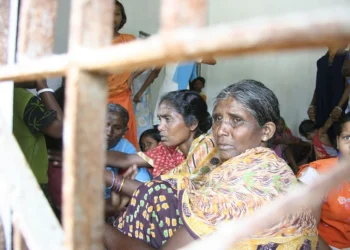Peter Franklin is an Associate Editor of UnHerd.
I have some upsetting news.
There’s no way of sugar-coating this — so I’ll just come out with it. The Conservative Party is dead. In fact, it’s been dead for quite some while.
An exaggeration, you say? Well, that depends on one’s perspective. Like all living things, a political movement needs a process of renewal. Fallen branches must replaced by green shoots, dried-up leaves by swelling buds. Interrupt that cycle and the end is only a matter of time.
That’s exactly what’s happened to our party. There’s nothing wrong with having older voters, but on average they die sooner than younger voters — and thus the issue of replacement is a more pressing need for us than, say, the Labour Party.
A quick reminder as to the extreme age-imbalance of our voter base.
In last year’s general election we won a 24% vote share among all voters — but, according to Lord Ashcroft Polls, it was just 14% among 18-to-24-year-old voters, 10% among the 25-34s and 13% with 35-44s. Precise age categories vary between different pollsters but they all paint a dismal picture. For instance, YouGov put our support at 8% among the 18-29s and 12% among the 30-39s. Then there’s Ipsos, which gave us just 5% among the youngest group of voters (18-24s), 10% with the 25-34s, and 17% with the 35-44s.
In short, among the under-40s we’re already a minor party. Just to be clear, that wasn’t always the case. As recently as 2015, YouGov had us on 32% among the under-30s.
I’ve written about our failure with younger voters before — as have other ConHome contributors. But today I want to ask why senior Tories refuse to engage with what is an existential issue for the party.
For instance, take a look at Kemi Badenoch’s leadership pitch at last year’s party conference. This is how she began: “It’s time to tell the truth. The truth about our party. The truth about our politics. The truth about our future.” And yet she makes no mention — no mention at all — of the collapse of Tory support among young voters. She had an opportunity to confront delegates with the greatest long-term issue facing us as a party, but she didn’t take it. Who was that said: “For too long politicians have told the public what they wanted to hear”? Oh yes, it was Kemi Badenoch.
Perhaps she assumes young people will turn Tory as they get older, buy their own homes, get married and have children. The obvious reply to that is: What homes? What marriages? What children? But just for once I’m going to avoid a rant about housing policy and family formation — and implore you to consider the bare psephological facts of our predicament.
The grimmest fact of them all is that if you consider all young people in the 18-24 age range, i.e. both voters and non-voters, something like 2% voted Conservative last year.
And among all 25-34-year-olds, it’s barely better at around 4%. To imagine that’s a basis on which to sustain the party’s voter base is like assuming that today’s teenagers will be getting landlines when they grow up or start watching terrestrial TV or become churchgoers out of a sense of social duty. There’s a reason why marketing experts are so obsessed with young people — it’s not just the cult of youth, but because it’s among this age group that new habits are formed and old ones die out.
But if an age-based death sentence has been passed on voting Tory, where’s the panic? Apart from a few Jeremiahs like yours truly, why do so few Tories take this seriously?
The number one reason is Reform UK.
Why care about the distant rumble of demographic doom, when an entirely different source of danger is already is staring us in the face? It’s a fair point. The Faragistes may have been tearing themselves to pieces of late, but they remain well ahead of us in almost every poll. If that’s still the case at the next election then we’re done for anyway.
And yet there’s a twist here that even Reform might like to pay attention to. The fact is that their party isn’t doing that well with young people either. In 2015, the combined Tory/UKIP vote share among the under-30s was 32% (according to YouGov). Last year, the Tory/RUK total was less than 20%. In other words, this isn’t just a Conservative problem, it’s a crisis for British Right in general.
Ah, but isn’t this an issue for the Right across the western world? Just look at the German general election last month in which support for Die Linke — the Left Party — surged among young people. And yet if you add up the vote share among the youngest voters for Germany’s Right-of-centre parties — i.e. 13% for the Christian Democrats, 5% for the Free Democrats and 21% for the hard Right AfD — the total is well above that for Britain’s Right-of-centre parties.
Or take America, in last year’s Presidential election, Kamala Harris won the youth vote — but only just. Donald Trump won 47% among the 18-29s compared to 51% among the over-65s. Then there’s France, where again the Left does best among young voters — and conservatism is in an even worse state then it is on our side of the Channel. And yet if we take into account Marine Le Pen’s Rassemblement National, the wider French Right — both mainstream and populist — does a lot better than its British counterpart. Certainly, Reform has no equivalent to the likes of Marion Maréchal (35) or Jordan Bardella (29).
I’ve searched for a single country in the which the Right-of-centre parties look quite as unappealing to young people as they do in the UK — and, so far, drawn a blank.
Reform UK is a party of feuding sexagenarians, not a youthful alternative to the Conservatives. It built its 2024 vote share by attracting alienated ex-Tories, the great majority of them from older age groups. In that respect, we should see Nigel Farage as the Grim Reaper’s wingman — accelerating the actuarial trends pointing towards our extinction.
There are some senior Tories — a few of them close to the leader — who get just how much trouble we’re in with younger voters.
They understand that, like Wile E. Coyote in a Loony Tunes cartoon, the Conservative Party has run off the edge of a precipice. Our past momentum with older generations will keep us going for a bit, but one day we’ll look down and realise there’s nothing but thin air beneath us.
The only question is how long have we got?
Decades, you might think — and yet it’s estimated that one-in-six Conservative voters will die by the time of the next election. That’s bad enough, but downright terrifying when you consider that there’s a cliff-edge in the electoral system — a point below which vote shares translate into a dramatically lower share of seats. With polls putting us in the low twenties, we’re already close to the danger zone — and so our long-term demographic problems threaten some devastating short-term consequences.
So do I see any cause for optimism? Well, there is one straw to clutch at — the fact that most young people don’t vote at all. There’s a 63% abstention rate among the 18-24s, 59% among the 25-34s and 52% among the 35-44s. That’s appalling, of course — but instead of tutting we could take it as a challenge.
Can we, as a party, develop an offer capable of inspiring a despondent, disengaged generation to vote for us?
I don’t know if we have the guts or imagination for such a mission, but one thing’s for sure — unless we provide hope for them, there’ll be no hope for us.







![‘We All Owe Him (Elon) a Huge Debt of Gratitude’ [WATCH]](https://www.right2024.com/wp-content/uploads/2025/03/‘We-All-Owe-Him-Elon-a-Huge-Debt-of-Gratitude-350x250.jpg)

![Trump's Admin Guts Another ‘Rogue Government Agency with Zero Accountability’ [WATCH]](https://www.right2024.com/wp-content/uploads/2025/03/Trumps-Admin-Guts-Another-‘Rogue-Government-Agency-with-Zero-Accountability-350x250.jpg)







